Women's Employment - United Nations Research Institute for Social ...
Women's Employment - United Nations Research Institute for Social ...
Women's Employment - United Nations Research Institute for Social ...
You also want an ePaper? Increase the reach of your titles
YUMPU automatically turns print PDFs into web optimized ePapers that Google loves.
Women’s employment in the textile manufacturing sectors of Bangladesh and Morocco<br />
whether this newly-incorporated labour <strong>for</strong>ce is subject to specific,<br />
gendered <strong>for</strong>ms of discrimination and exploitation (Elson and Pearson,<br />
1981). They have also been concerned with the impact of women’s<br />
employment in export-oriented industry on gender relations; on<br />
whether such employment provides women with greater autonomy<br />
and choice, or merely reproduces a new variant of patriarchal gender<br />
relations (see, <strong>for</strong> example, Greenhalgh, 1985; Kabeer, 1995).<br />
Underpinning these debates is Sen’s concept of “perceived<br />
contribution” as a factor in increasing women’s bargaining power<br />
within the household (Sen, 1990). In this view, earned income through<br />
wage employment may contribute more to the women’s status than<br />
less visible <strong>for</strong>ms of economic activity.<br />
2. Labour markets and gender discrimination<br />
Since the mid-1980s, a considerable theoretical and empirical<br />
literature on labour markets and discrimination (by gender and other<br />
variables) has emerged based on studies of developing country labour<br />
markets. These come from a range of perspectives, including<br />
neoclassical (Appleton et al., 1990; Birdsall and Sabot, 1991;<br />
Psacharopolous and Tzannatos, 1992; Hotchkiss and Moore, 1996;<br />
Glick and Sahn, 1997) as well as institutional and feminist viewpoints<br />
(Humphrey, 1987; Sinclair and Redclift, 1991; Terrell, 1992).<br />
These studies have provided a wealth of evidence on the extent<br />
of the male-female wage gap in different contexts, the degree to which<br />
this can be attributed to “discrimination”, and on other mechanisms<br />
of discrimination in labour markets. The range of estimates of malefemale<br />
wage differentials varies between countries, sectors and time<br />
periods, as well as between different groups of women. For example,<br />
studies cited in Ashenfelter and Oaxaca (1991:43-47) report earnings<br />
differentials from as low as 27 per cent (Brazil, <strong>for</strong>mal sector) to as<br />
high as 85 per cent (Nicaragua, national). Hotchkiss and Moore<br />
(1996:671) find a gross earnings differential of around 20 per cent <strong>for</strong><br />
Jamaica. Terrell (1992:393) reports female earnings as a percentage of<br />
male at between 47 per cent and 87 per cent, <strong>for</strong> a variety of Latin<br />
American countries. The proportion of these differentials that is<br />
thought attributable to discrimination (rather than differences in<br />
endowments) is also highly varied, ranging between 10 per cent and<br />
over 100 per cent, depending on country, sector and education level,<br />
inter alia, with many estimates at over 60 per cent of the wage gap<br />
(Ashenfelter and Oaxaca, 1991:47; Psacharopolous and Tzannatos,<br />
1992; Terrell, 1992). Aggregate gender discrimination may disguise<br />
36
















